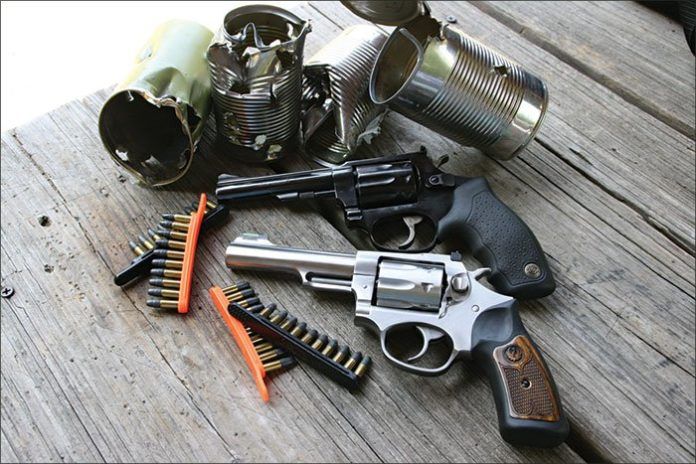We recently looked at new stainless steel Ruger SP101 ($699) and a used Taurus Model 94 ($300) with an eye toward finding a Bargain Hunter kit gun — generically, a knockabout handgun that was substantial enough to go into the backcountry as a plinker or small-game getter, but which didn’t have to cost and arm and a leg. After the tin cans stopped jumping, we wound up with two vastly different, but very good recommendations, as kit guns. In more detail, the two contestants were a Ruger SP101 #5765 KSP-242-8 and a used Taurus Model 94, both small-frame, double-action revolvers with 4-inch barrels, adjustable sights, and high-capacity cylinders. They are chambered in 22 LR but are also compatible with 22 CB caps, 22 Shorts, 22 Longs, and 22 LR shotshells loaded with #12 shot. Besides their versatility, it’s usually possible to replenish your stores of 22 cartridges pretty much anywhere that sells ammo.
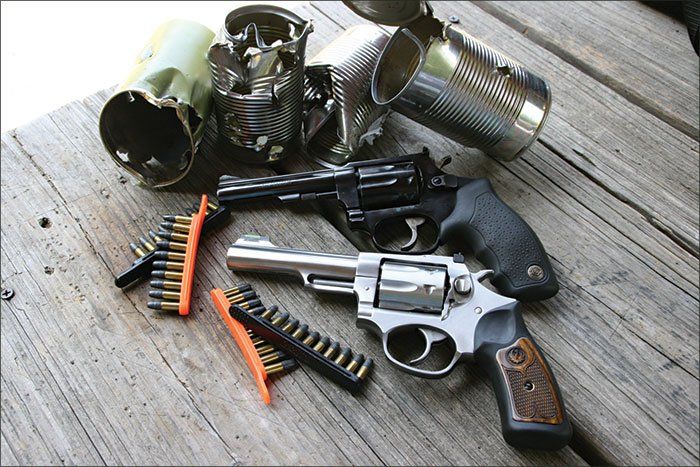
In addition to simply finding the better handgun, the task here was to decide what was enough gun for this role without spending unnecessary money. With that caveat thrown in, the Taurus had a huge initial lead because it cost so much less — about $399 cheaper than list and about $235+ cheaper than prices at Cheaper Than Dirt! ($536) and Bud’s Gun Shop ($540), not counting transfer fees, shipping, sales taxes and other associated costs. Our used Taurus test gun was most similar to the current production model 94B4 #2-940041, which also has a nine-shot capacity and a 4-inch barrel, a 5-inch height, and an OAL of 8.75 inches. The major difference is the new model has a full lug barrel and a price of $438. Assessing the Taurus test gun’s condition, we gauged it at 90%.
To get things started, we cleaned the 94’s bore thoroughly, scrubbing it with a bronze brush after letting it soak in bore cleaner. Then we tried to use a Brownells range rod (Brownells.com) to test the chamber-to-bore alignment, but the 94’s bore was tight and the 22-caliber head did not fit, so we didn’t force it. We thought, at worst the undersized bore would have an effect on accuracy. We hoped it would be positive. With the Ruger, we discovered all chambers were indeed aligned with the bore.
Off sandbags at 15 yards using the guns’ open sights, PMC Target 40-grain roundnose ammo delivered shockingly good results in the Taurus, shooting a best-of-test 0.48-inch group on the way to an five-shot average group size of 0.68 inch, not quite half the size of the Ruger’s 1.30-inch average. The Ruger did produce a marginally faster average velocity of 838 fps to the Taurus’s 829 fps.
Remington Thunderbolt 40-grain roundnose ammo was a coin flip in average group accuracy, with the SP101 taking a tiny 0.96-inch edge over the Model 94 at 1 inch. The Taurus produced better velocity with this round, however, 884 fps to 862 fps.
CCI Mini-Mag 40-grain roundnoses produced groups likewise too close to call, with both handguns spitting out average group sizes of 1.20 inches, though the SP101 had the smaller best group, 0.78 inches to 1 inch for the Model 94. Velocity slightly favored the Ruger, 1005 fps to 992 fps.
All in, we found these small revolvers were well suited for plinking and small-game hunting, but we thought one offered more value.
Taurus Model 9422 LR, $300
The Model 94 looked like an old-school S&W since it was blued with a small, partial lug that protected the front of the ejector rod but did not lock up with it. The cylinder locked into the frame at two points: the rear of the ejector and a detent in the top of crane mated to a notch in the frame. The gap between frame and crane was tight and there was some wiggle in the cylinder lock up, but we gauged the play to be not excessive. It did not look like this revolver had much trigger time. The Model 94 felt lighter than the Ruger, but it was actually 2 ounces heavier, which had to do with the balance of the gun in hand. Muzzles of both revolvers were crowned for protection if accidentally dropped muzzle first.
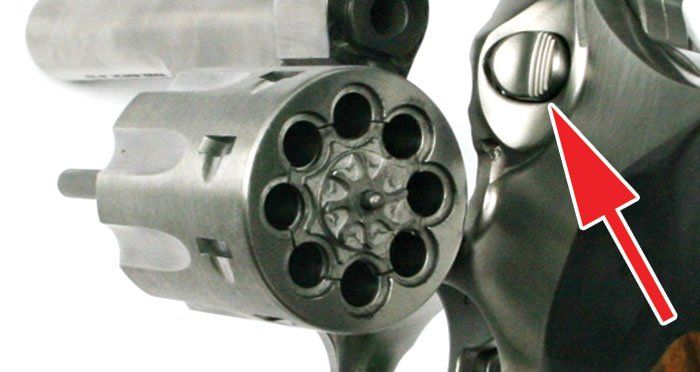
The cylinder latch was full size, which we liked since this soft-shooting revolver didn’t jam the latch into our thumb knuckle during recoil. We did not use a speed loader, but we did try out Tuff Quick Strips (TuffProducts.com), which held 10 rounds of 22 LR and allow a user to load two chambers at the same time. The strips are flexible polymer and are easy to fill. They keep rounds secure in a pocket and allow for a fairly fast reload. The Model 94 held nine rounds.
The 94 used a set of Taurus rubber grips with finger grooves, which we thought were well suited for this small revolver. They were small, yet had a nice palm swell. Also on the small side were the sights. The 94 had a fixed, serrated-ramp front sight milled into the barrel. The rear notch was tiny and adjustable for windage and elevation via a small flat-blade screwdriver. The rear sight unit extended over the frame top strap and was serrated. At 15 yards, the tiny sights took more effort to use, but we were able to squeeze out 1-inch groups on average. We much preferred the Ruger’s sights, which we describe below.
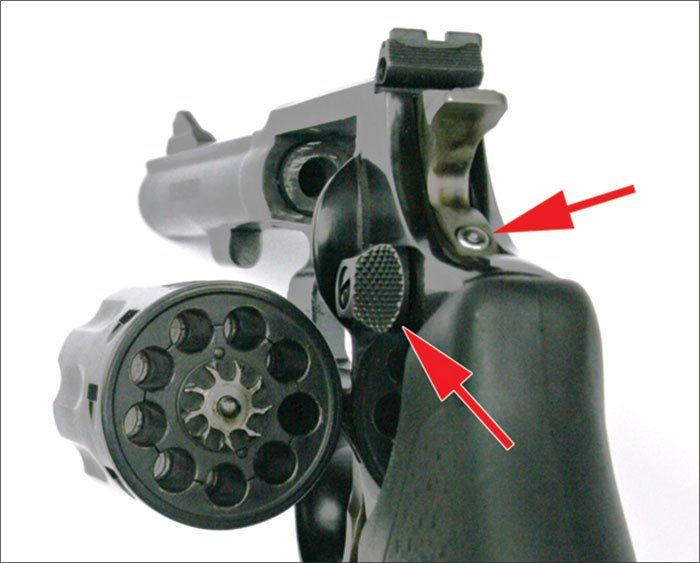
The trigger was wide and smooth and had a nice curve to it that was comfortable to shoot, though the DA trigger pull was too heavy — 12 pounds. The action felt smooth, but the DA pull was a tad too much for accurate work, we thought. The hammer spur had a checkered square pad that was toothy and non-slip when thumbing back the hammer. The transfer-safety bar is used in the mechanism, so the Model 94 could be fully loaded with no fear of an accidental discharge if dropped on the hammer over a live round.
Our Team Said: The Taurus went bang every time we pulled the trigger and had acceptable accuracy. The used Taurus was certainly worth the money if you wanted an inexpensive kit gun, but you will have to put up with the tiny sights and heavy DA trigger pull.
Ruger SP101 #5765 KSP-242-822 LR, $699 List; $540
The SP101 followed Ruger’s design philosophy of making ruggedly built revolvers. The Ruger and Taurus were both on the hefty side compared to some kit guns we’ve tested. The SP101 looked sharp out of the box with a matte-stainless finish and rubber grips with wood inserts. The wood inserts are checkered and engraved with the company logo. The lock up was tight and the action smooth.
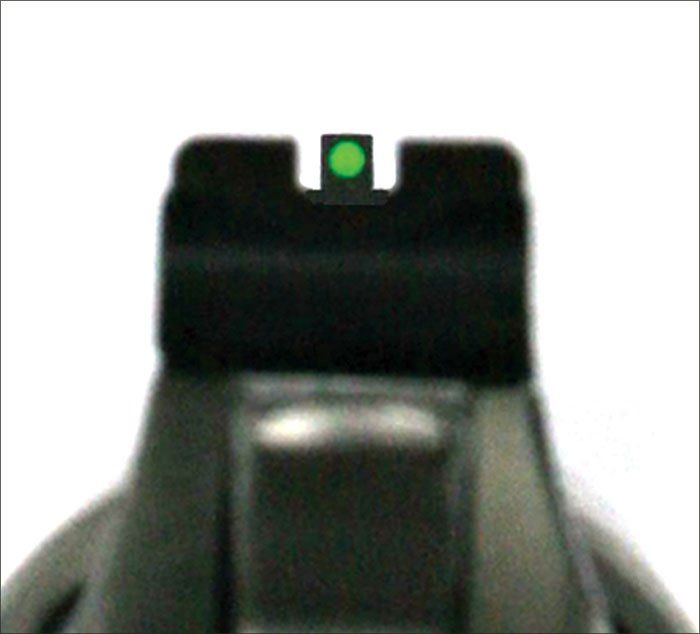
The hammer spur was coarsely checkered for a non-slip grip, and the trigger shoe was wide and smooth. The trigger pull was 12 pounds — just like the Taurus. We thought both were too heavy, but we found the Ruger steadier to shoot in DA. The cylinder latch on the SP101 is squeezed into the frame, unlike the Taurus, which is pushed along side of the frame. The cylinder of the SP101 was easier to access than the Taurus since the end of the ejector dragged along the recoil shield; a notch is cut out in the recoil shield on the Ruger so that it moves freely.
The ejector rod was enclosed in a partial under lug. The rod itself was plain while the end of the rod on the Taurus was knurled. The SP101’s cylinder locked up at the rear of the cylinder via the ejector and at the front by a massive detent in the crane. As mentioned, the lockup was tight and secure, and we’d expect it to stay that way for a long time.
The rear sight was matte black and adjustable for windage and elevation via two small slotted screws. You would need a small flat blade screwdriver to make adjustments. The front sight was dovetailed into a raised portion of the muzzle with a green fiber-optic tube that glowed brightly in light and just appeared green in dim light. The rear notch was wide and the green dot bright, so target acquisition was fast. The top of the barrel was machined with fine grooves to reduce glare.
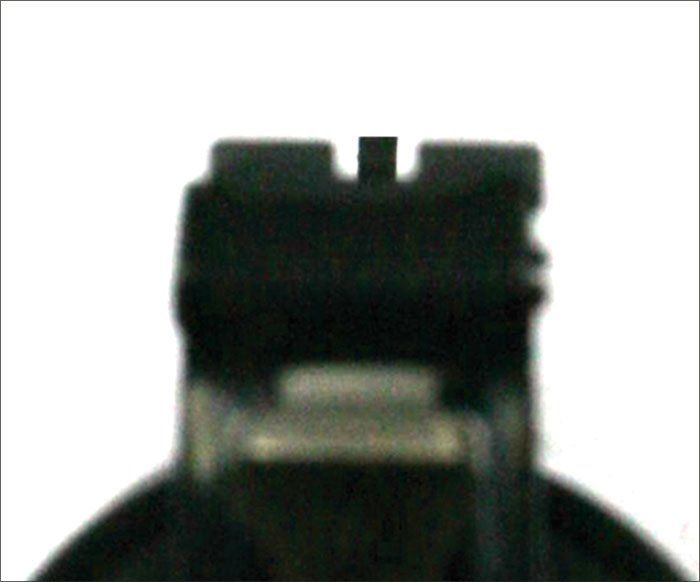
In hand, the grips felt chunky for some testers compared to those on the Taurus, but they were comfortable to shoot. Loading was simplified and faster with the Tuff Quick-Strip. As we noted above, the Taurus was noticeably more accurate with the PMC Target ammo and the handguns were tied in average group size with the Remington Thunderbolts and CCI Mini-Mags.
Our Team Said: The Ruger’s sights and finish upgraded the kit-gun concept, we thought. The low-maintenance stainless-steel finish was a big plus. Though the cost was hundreds more than the used Taurus, we felt the SP101 could be in someone’s kit for generations to come.
Written and photographed by Robert Sadowski, using evaluations from Gun Tests team testers.



























